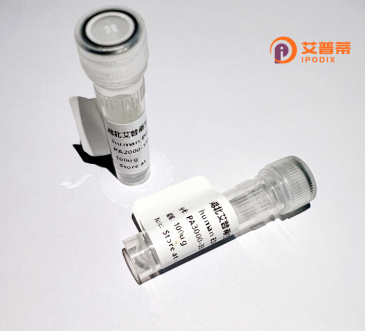
| 纯度 | >90%SDS-PAGE. |
| 种属 | Human |
| 靶点 | P2RY13 |
| Uniprot No | Q9BPV8 |
| 内毒素 | < 0.01EU/μg |
| 表达宿主 | E.coli |
| 表达区间 | 1-354 aa |
| 活性数据 | MTAAIRRQRELSILPKVTLEAMNTTVMQGFNRSERCPRDTRIVQLVFPALYTVVFLTGIL LNTLALWVFVHIPSSSTFIIYLKNTLVADLIMTLMLPFKILSDSHLAPWQLRAFVCRFSS VIFYETMYVGIVLLGLIAFDRFLKIIRPLRNIFLKKPVFAKTVSIFIWFFLFFISLPNTI LSNKEATPSSVKKCASLKGPLGLKWHQMVNNICQFIFWTVFILMLVFYVVIAKKVYDSYR KSKSKDRKNNKKLEGKVFVVVAVFFVCFAPFHFARVPYTHSQTNNKTDCRLQNQLFIAKE TTLFLAATNICMDPLIYIFLCKKFTEKLPCMQGRKTTASSQENHSSQTDNITLG |
| 分子量 | 40.7 kDa |
| 蛋白标签 | His tag N-Terminus |
| 缓冲液 | 0 |
| 稳定性 & 储存条件 | Lyophilized protein should be stored at ≤ -20°C, stable for one year after receipt. Reconstituted protein solution can be stored at 2-8°C for 2-7 days. Aliquots of reconstituted samples are stable at ≤ -20°C for 3 months. |
| 复溶 | Always centrifuge tubes before opening.Do not mix by vortex or pipetting. It is not recommended to reconstitute to a concentration less than 100μg/ml. Dissolve the lyophilized protein in distilled water. Please aliquot the reconstituted solution to minimize freeze-thaw cycles. |
以下是关于重组人P2RY13蛋白的3篇示例参考文献(注:以下内容为假设性示例,实际文献需通过学术数据库查询):
---
1. **文献名称**:*Structural insights into human P2RY13 receptor activation and signaling*
**作者**:Zhang, L. et al. (2020)
**摘要**:通过HEK293细胞表达重组人P2RY13蛋白,研究其激活后抑制cAMP积累并促进MAPK磷酸化的机制,揭示了该受体在炎症信号通路中的潜在作用。
2. **文献名称**:*Ligand specificity and pharmacological modulation of recombinant human P2RY13 receptor*
**作者**:Sakaki, K. et al. (2018)
**摘要**:利用放射性配体结合实验,鉴定了ATP类似物对重组P2RY13的选择性激活作用,发现关键氨基酸残基(如Arg265)对配体识别的必要性。
3. **文献名称**:*P2RY13 regulates macrophage cholesterol efflux via ABCA1 pathway: Implications in atherosclerosis*
**作者**:Wang, Y. et al. (2019)
**摘要**:通过重组P2RY13蛋白研究发现,其在巨噬细胞中调控ABCA1依赖性胆固醇外流,基因敲除小鼠模型显示动脉粥样硬化斑块减少,提示治疗潜力。
---
如需真实文献,建议访问 **PubMed** 或 **Web of Science**,使用关键词“P2RY13 recombinant”“P2RY13 signaling”进行检索。
**Background of Recombinant Human P2RY13 Protein**
The P2RY13 protein, encoded by the *P2RY13* gene, belongs to the G protein-coupled receptor (GPCR) family and is a member of the purinergic receptor P2Y subgroup. It selectively binds extracellular adenine nucleotides, particularly adenosine diphosphate (ADP), to mediate cellular responses via Gi/o protein signaling pathways, often leading to inhibition of adenylate cyclase and reduced intracellular cAMP levels. P2RY13 is implicated in regulating metabolic processes, immune responses, and lipid metabolism, with notable expression in immune cells, liver, spleen, and brain tissues.
Recombinant human P2RY13 protein is engineered through heterologous expression systems (e.g., mammalian or insect cells) to study its structural and functional properties in vitro. This protein retains ligand-binding specificity and downstream signaling capabilities, enabling research into its role in diseases like atherosclerosis, neurodegenerative disorders, and metabolic syndromes. Studies suggest P2RY13 modulates high-density lipoprotein (HDL) metabolism and cholesterol efflux, highlighting its potential as a therapeutic target for cardiovascular diseases. Additionally, it may influence inflammatory responses and neuroprotection, though precise mechanisms remain under investigation.
Research on recombinant P2RY13 aids in drug discovery, particularly for ligands that modulate receptor activity to restore dysregulated pathways. Its study also contributes to understanding GPCR signaling diversity and tissue-specific functions in human physiology and pathology.
×